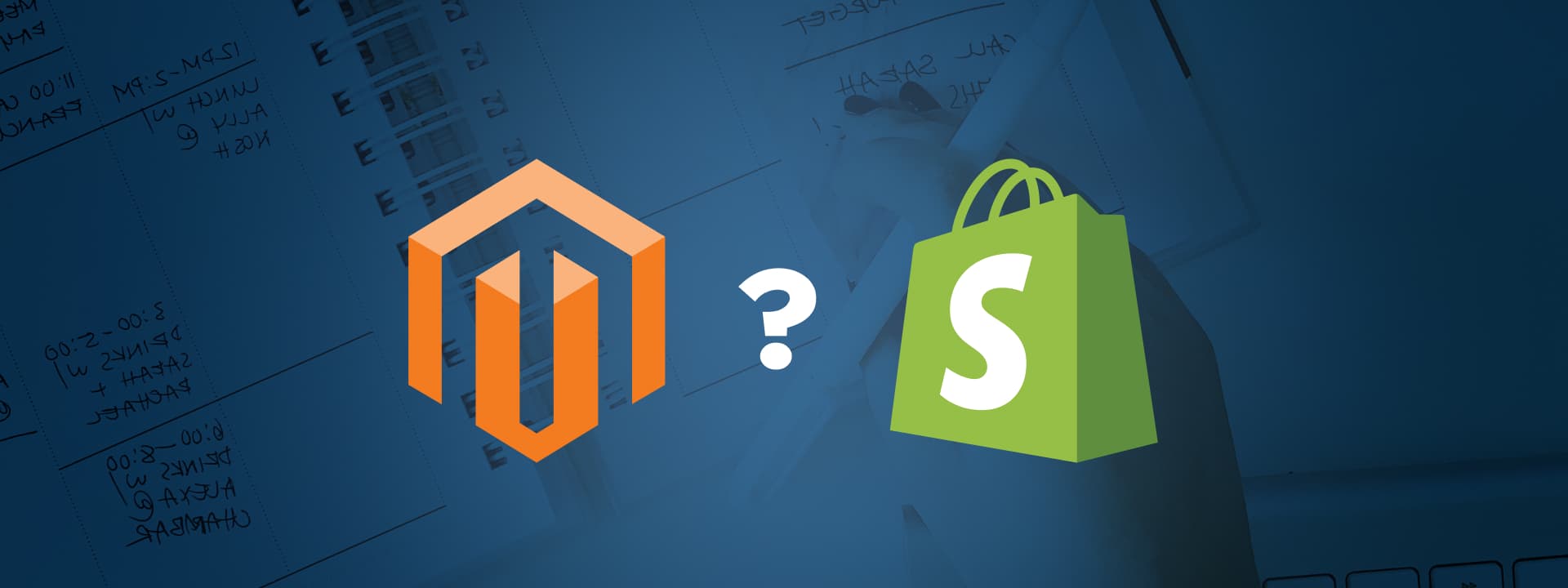
How to Migrate From Magento to Shopify
In 2022, the United States of America had:
- Customers spend approximately $1.17 trillion.
- Expected eCommerce sales worth $904.9 billion.
- 268 million eCommerce buyers.
- Around 2.5 million eCommerce businesses.
This means:
- There is one eCommerce business for approximately every 107 buyers.
- eCommerce sales will account for almost 77% of all sales in the United States.
And as the digital wave continues, the number of digital shoppers and eCommerce stores and sales will only increase. So, deciding which eCommerce platform is fit to become a catalog of your products/services is really the conundrum of the hour.
Magento was once the crowned king of the eCommerce market, with every player loving the features and accessibility it offered. (Sure, Magento has certain flaws like a huge learning curve and high hosting costs associated with it — but who amongst us doesn’t have their faults?)
But what if we said you don’t have to put up with these faults anymore?
Yes, there’s a new leader in the market now, and that’s Shopify. We’re sure you’ve heard of its name, but if you wish to know why you should begin migrating from Magento to Shopify and how to migrate from Magento to Shopify, then stick around, as this article is for you.
- Why do people prefer Shopify instead of Magento?
- Migrating via using the store app
- Manually migrating Magento to Shopify
- Data migrating from Magento to Shopify
- Magento to Shopify migration checklist
- Should I hire an expert for migration?
- Conclusion
Why do people prefer Shopify instead of Magento?

The primary reason why users prefer Shopify over Magento is because of the easy accessibility it offers — for example, you’d have to learn to code (and would have to know coding beyond just the basics) to set up a Magento website. However, the same is not true for Shopify, as it has readymade themes that users can just customize to their liking. So, Magento users have to be prepared to shell out some big bucks to web developers (or learn to code themselves).
Another area where Magento lacks is its hosting service (for context, one of the pros of Magento that pulls people in is that it’s open source, but when people actually go to host the site, doing so requires expensive hosting fees — so they end up feeling bamboozled). Conversely, Shopify includes web hosting services within its pricing plan, so users know what they’re paying for before they get started.
But the cost of web hosting is not the only pricing users are concerned about. If users are seeing great success with their sales, and want to buy a premium version of the eCommerce site to get more functionality, then the Magento 2 Enterprise may end up costing around $30,000 – $50,000 annually. If the same thing were to take place for a Shopify site, then the Shopify Plus platform would cost around $2000/month (which comes up to $24,000/annually).
Aside from these factors, first-party POS systems, unlimited bandwidth, free subdomain, free SSL certificate, blog inclusion, mobile app support for store users, PCI-DSS compliance, and detailed sales reports are other features that Magneto doesn’t provide (but Shopify, in turn, provides all these).
Migrating via using the store app
Say, if you were already on Magento, then instead of closing the store there and reopening a new store on Shopify, it’s entirely possible to just migrate your data from Magento to Shopify. There are two ways to do that:
- Migration using the store app
- Manual migration
We’re discussing the former in this section. Migrating using a store app may have its own list of cons (such as it’s difficult to migrate coupons, reviews, gift cards, custom reports, visitor traffic data, and orders, passcodes cannot be migrated, and only the first 10,000 SKUs can be migrated for free — post the fee that is applied for migration).
However, there are benefits of migrating to the store using the app too. For one, app-based migration is extremely secure, you don’t run into fears like losing any data, and it’s entirely effortless to transport data there.
So, without further ado, let’s go right ahead and understand how to migrate data from Magento to Shopify using the store app.
Step #1: Create a data backup
Before you even think of migration, check that you have a solid data backup. Here’s how to ensure that you have your data in place:
- Click on the sidebar that says “Admin.”
- From there, select the option “System.” Once there, click on “Tools” and “Backup.”
- Decide if you want a systems backup, a database backup, or database and media backup.
- If a pop-up box appears, add a backup name, and click on “OK.”
- Wait till the time your backup is created.
Pro Tip: Your hosting provider might provide automatic data backups, too.
Step #2: Make a Shopify account
Shopify has three different types of plans: “Basic,” “Shopify,” and “Advanced.” Alternatively, there’s “Shopify Plus” available too. The aforementioned plans come with free trials, so you can check out which option works best for you. From there, Shopify will ask you a few questions like:
- What would you like to sell?
- What do you plan to sell first?
- Name of your Shopify store
- Where will your business be located?
And voilà, you have your store ready!
Step #3: Get the “Import Store” app and export data
Many experts recommend downloading the “Import Store” app to help you with data migration. However, there are other apps on the software, too, like Excelify, Multichannel Importer, and Bulk Product Editor and Sync.
Once you’ve accomplished all the above steps, now it’s time to migrate the data. Go to Magento, and click on the Admin sidebar. From there on, select “System” > “Data Transfer” > “Export.” Once there, you’ll have to click on one of three options:
- Products
- Customer main file
- Customer address
Select “XML” as file format if using the store app or CSV if migrating manually.
Step #4: Import and review data on Shopify
We’re at the final step! After you’ve been through all the above steps, go to Shopify, and click on “Apps.” Select “Import Store” > “Magento” > “Upload Files” > “Add Files.” You will need to add your exported data here and select “Continue Import” > “Import.”
Your task is complete here — just make sure you review all the data you’ve imported so that there are no errors (you can review this in the import summary after clicking on “View Items.”)
You’ll also need to design your Shopify store from here on, but that’s a story for another day.
Manually migrating Magento to Shopify

While app-based migration offers tons of benefits, some users might still prefer to migrate their data the old school way (aka, manually). And we can see why this option might tickle their fancy because, frankly, manual migration makes users more comfortable with the software, allows them to review every stage of migration (thereby reducing errors), and so much as even presents the opportunity to rework some of the current capabilities of the site.
However, if there’s a lot of data to be dealt with, then you can kiss manual migration goodbye. Because although it allows users to review and rework the data and makes them more comfortable with the software, it also comes with the possibility of human errors and has costly human capital.
Now that we have presented all the pros and cons, without further ado, let’s understand how to migrate data to Shopify from Magento manually.
Step #1: Follow all the steps mentioned above
Shopify manual migration is quite similar to Shopify app-based migration. For the same reason, all you have to do is copy steps 1-3 mentioned in the above section (except the part about the “Import Store” app). However, instead of selecting the “XML” file format, you’ll click on the “CSV” file format at the end of step #3.
Step #2: Decide how you want to migrate data and review your site
There are two ways to execute manual migration:
- By selecting CSV as the file format
- By copy-pasting content
Experts recommend that you follow a sequence when migrating to Shopify manually, as it’ll help you keep track of your data (the ideal sequence is Products > Customers > Historical Orders). Once this is done, you should ideally check your site to see if there’s no room for human error and if all data has been accurately captured.
Some users also preferred to use solutions like LitExtension or hire experts from MTN Haus to make the process of manual migration easier.
Data migrating from Magento to Shopify
To ensure that you migrate all information from Magento to Shopify without causing any data leaks, we recommend you take count of the following aspects to ensure that nothing is missing:
- Products and their categories (ensure that you have everything from the name, images, product descriptions, alt text, feature information, color options, size options, price, slug, meta description, variants, meta title, stock information, etc.).
- Website data (take everything with you, including the About Us page, the Contact Us page, blogs, graphics, images, and CMS pages).
- Order Info (customer data, addresses, prices, order status, payment details, product info, purchase details, etc.).
- Integrations and automation (ensure that all your systems and integrations stay in place as they were on your old site).
- Other aspects like discounts, static sources, coupons, links, and SEO structure.
Magento to Shopify migration checklist
Alright, let’s see what you missed and what steps you’ve fulfilled. Mentally tick on the boxes that are a “yes.”
- Have you created a data backup (even if you think your hosting provider may provide one)?
- Have you made a Shopify account and set up a site?
- Did you download the “Import Store” or other similar apps (if working with app-based migration)?
- Did you go to Magento and select System > Data Transfer > Export?
- Did you select XML (if app-based) or CSV (if manual) as file format?
- Did you import the data (and in the correct order)?
- Did you review all data to ensure that you’ve not missed out on anything or that there are no data leaks or errors?
If your answer is “yes” to all questions, then you should begin designing your Shopify site!
Should I hire an expert for the migration?
The short answer is yes. The long answer? Well, data migration is a tricky process — but it’s also something you want to get right (after all, if there are any data leaks or if there are any issues on your site, it means that you may end up waving your prospects goodbye). So, to ensure that your site looks top-notch, all your data is right where it’s supposed to be, and there’s nothing that will deter a prospect from checking out your new location for eCommerce, you need an expert to get the task done for you.
Another reason for hiring an expert is that they’ll end up saving you money in the long run (yes, by keeping your prospects on your site, for one). But, if you end up doing the task of migration (especially manual migration) by yourself, then you’ll have to go through plenty of loops of trials and errors. However, since experts know what exactly to do, they likely won’t go through the same loops as you, which means that they’ll end up saving you (and your team) some time that may be well spent doing other activities of your business.
Conclusion
In the previous section, we discussed how a reputable site might need experts to get the job done. In this section, we want to illustrate how important it is that the experts know exactly what they’re doing (because if they do something wrong or if they end up wasting the same amount of time and energy as you might flying solo, then what’s the point of hiring them — right?)
So, before you begin your search of finding the perfect expert for setting up your Shopify store and migrating data from Magento, may we suggest ourselves? MTN Haus is a Shopify Plus partner and has long served clients like Native Path, LMNT, C.Krueger’s, Music Today, Hammer Nutrition, and more.
We know what we’re doing, and we do it well. So, if you wish to hire the real experts (as certified by Shopify itself), then get in touch with MTN Haus.




